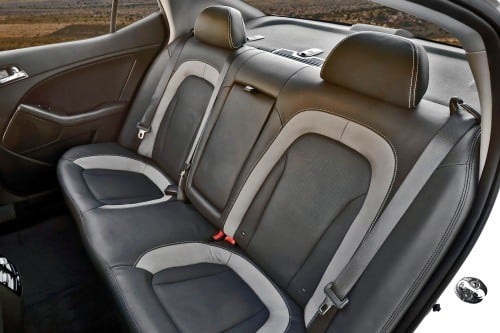Thursday, August 30, 2012
Wednesday, August 29, 2012
Tuesday, August 28, 2012
Hybrid Sedan Face-Off: Kia Optima vs. Toyota Camry
As it heads into its second generation as a hybrid, the Camry Hybrid is powered by a 156 horsepower, 2.5 liter 4 cylinder motor, mated to the drive train with a CVT. Unlike the fully equipped regular Camry, the Hybrid model does not come with the extra trim pieces around the body, keeping the clean, smooth lines the Camry is known for. The power allows for quick acceleration off the line, and while not as smooth as a regular vehicle, it is quick enough to get to speed when necessary.
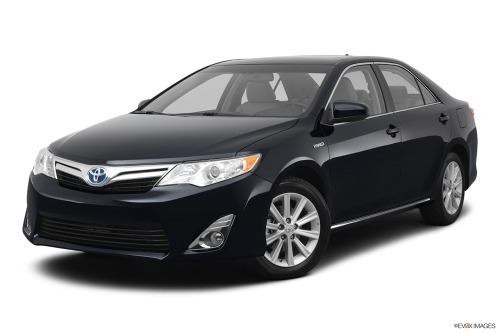
With that though, the transition from electric (EV) mode to powered comes with a physical hiccup, a delay that isn’t as smooth as the Prius model. Even though the whole setup is very similar, the Camry Hybrid does not feel as refined as its sister, and that came as a bit of a disappointment as I cruised all over the state. The Camry will still run on full electric up to 27 mph, but after that, the 2.5 liter motor is a bit underwhelming.
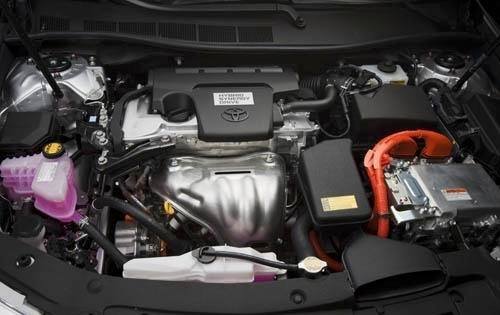
And that feeling does not end at the power. Inside the Camry, the technology integrated feels already outdated, with analog gauges, an outdated navigation and multimedia unit, and overall inexpensive materials used for the build. While this is not an article comparing the Prius to the Camry, it’s difficult to go from a ride that has stepped its game in regards to quality and hybrid technology to one that feels left behind.
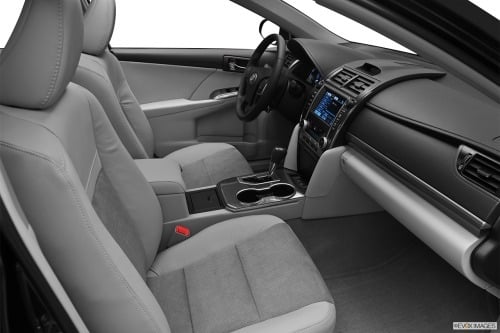
Overall comfort of the Camry Hyrbid is there though, as the lineup has always been known for. It’s a smooth riding vehicle able to handle rough roads and corners like most family sedans. Even with the increased weight from the hybrid drive train, the Camry Hybrid actually felt sportier than the previously reviewed SE Limited Edition, which came as a big surprise. Sadly, even when cruising the highway, it wouldn’t go to full EV mode except going down hill or coasting, which felt a bit like an misstep on Toyota’s end.
The controls on the steering wheel were the standard features, and overall, the vehicle left no major bad taste in my mouth as it’s just a Camry, a vehicle known for being safe, easy to drive, and sadly bland.
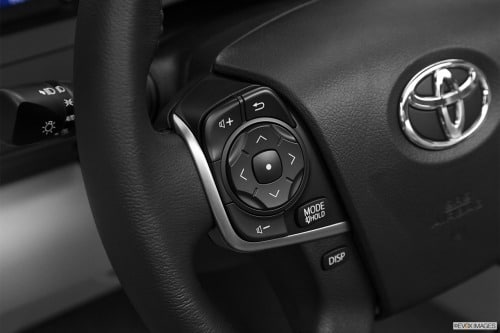
Now lets look at the Kia Optima Hybrid, a vehicle new to the green market, and coming fast and strong. Powered by a 166 horsepower, 2.4 liter 1-4 motor, mated to a 6-speed automatic transmission with auto-manual, this new ride has quite a kick for a hybrid.
Pressed hard off the line, the tires were able to lose traction every now and then, and acceleration to speed was quick and smooth. The transition from electric and to powered is quite a bit smoother than the Camry, but still has a bit of lag. That is honestly to be expected. The interaction between the two systems is very seamless, and aside from the physical hiccup, is of little notice while driving. Unlike the Camry Hyrbid, the Optima is able to go under electric power up to 40 before transitioning, and uses both energy sources for hard-hammered driving.
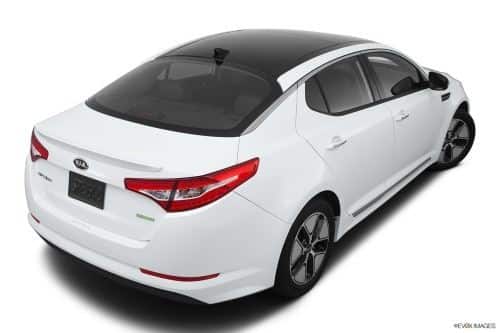
Inside the Optima was a different story than the Camry, with a fully loaded an integrated multimedia system packed full of driving information useful and easy to access. The screen between the two gauges provided all the information needed, from driving habits to navigation, all accessible through the steering wheel.
The quality of the interior pieces carries over the great styling from outside, with a solid touch to every aspect inside. This is not your every day, mom and pop grocery getter. No, this Optima Hybrid is class and style all wrapped up in curves, glass, and leather. The glass is very important here as there is quite a bit of it, even on the roof with a panoramic moonroof.
Driving the Kia Optima Hybrid was a joy, with solid acceleration and braking, and a very sport feel even through canyon runs. The tires that wrap the 17-inch wheels though are a bit soft though, and honestly I would replace them with a set that is provides more grip. The suspension was able to keep up with all over the divots and bumps that come with driving, and inside road noise was minimal.
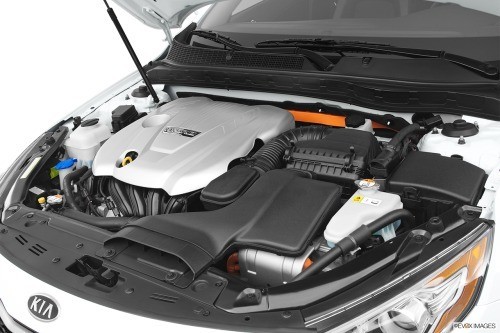
While front seat comfort was great, there is a downside to the sloping back of the Optima. Headroom was lacking for my 6ft 1in frame, and even slouched, got a bit close for comfort. And while the ride might not be aimed towards drivers with full grown passengers all around, it would have been nice to be able to fit in the back for those times it would be necessary.
Both the Camry Hybrid and Optima Hybrid as equally priced fully loaded, but differ in so many other ways. From the build quality to the integrated technology, the Camry is left in the dust by the Optima. The Camry is bland and outdated inside the ride, leaving little to the imagination when it came to driver comforts, with a few things like heated seats, navigation, and a nice clean look. The Optima felt stuffed to the brim with everything imaginable, from heated and cooled seats to a great technology system providing all sorts of useful data, all surrounded by a solid feeling dash in a cabin that where you feel safely confined.
Hybrids may be here to stay, even against many wishes of writers like myself, but there is no reason they should be boring. Eco doesn’t mean bland, but unfortunately for Toyota, that is exactly what the Camry Hybrid is on the road. And with Kia bringing a better-equipped vehicle to market, costing less than the Camry, there honestly is little excuse for bland. The Kia Optima Hybird has set the standard, and its currently out of reach for the Camry Hybrid.
Thursday, August 23, 2012
10 Best Tailgating Vehicles of 2012

Click here to read the entire list!
Wednesday, August 22, 2012
Tuesday, August 21, 2012
2013 Kia Sorento to have more power trains, better economy

The Sorento will come with a standard six-speed transmission in either manual or automatic, no matter the market, and will come in a choice of 2-wheel or 4-wheel drive (2WD, 4WD) with a front-wheel-centric drive train. The 4WD option is on-demand and includes an automatic torque differential to send power from front to rear and back as needed. An optional "lock" mode splits power 50:50 between front and rear and disables the torque differential.
New styling for the Sorento means the aerodynamic drag coeficcient (Cd) is down to 0.34 with sleeker styling and a more updated look. Kia plans annual sales of 265,000 units globally.
New Gasoline Engine Update
The new gasoline engine in the Sorento is a 2.4-liter Theta II GDI (gasoline direct injected) with a newly-designed cylinder head, upgraded pistons, and new fuel injection and intake systems design. It generates 9% more power than its predecessor at 189 horsepower and 6.6% more torque (now 178 lb-ft) with the GDI update from the previous MPI system. It delivers better fuel economy and fewer emissions at teh same time.
Some markets will see the 3.5-liter Lambda V6 MPI as well as the 2.4-liter Theta II MPI offered last year. European buyers will have a 2.0-liter R2.0 TCI as well.
New Diesel Engine Update
A new 2.2-liter TCI (turbocharged inter-cooler) diesel engine puts out 194 horsepower and includes a new exhaust gas recirculation (EGR) system, reducing emissions. This engine is not planned for North American sales, however, but will be offered throughout Europe and Asia.
In the North American market, the Sorento starts at $23,150 MSRP for 2013 and includes a 10 year/100,000 mile warranty.
Thursday, August 16, 2012
Wednesday, August 15, 2012
Air Filter Service - Starting at $28.95!

Stop in and get your Air Filter replaced starting $28.95!
Tuesday, August 14, 2012
Report: Kia Updating or Releasing Seven Models By 2015
Automotive News reports that Kia’s major models, including the Soul, Sorento, Sportage, Optima, and Forte will receive updates around 2014. The Forte sedan–which we’ve already seen as the K3/Cerato sedan–will debut in January of this year, with a Forte Koup coupe and five-door hatchback following a few months later. The Optima will be due for a mid-cycle refresh in 2014, with some as-yet-undetermined visual changes coming in the summer of 2013. The U.S. market Sorento will follow the international-market model, and receive minor visual changes as Kia places it atop the new Hyundai Santa Fe platform. The Sportage, meanwhile, will get a new grille and front fascia, and arrive in dealers late next summer as a 2014 model.
The Soul will receive some similar chassis upgrades – yes, it’s due for a full redesign, but the boxy hamstermobile will also now ride atop the new Hyundai Accent/Kia Rio. Don’t expect a serious change to the car’s look, however, as the Soul’s boxy, funky aesthetic has brought it plenty of success.
With those upgrades already in process, Kia’s focusing some of its energy on two new models, the Cadenza and Quoris. The Cadenza will be a front-wheel drive large sedan powered by a 3.5-liter V-6 engine, making it essentially a Kia version of the Hyundai Azera. The Quoris, meanwhile, will ride atop a rear-wheel-drive platform and use a 3.8-liter V-6 and an eight-speed automatic transmission–sound familiar? It’s quite similar to the Hyundai Genesis sedan. The Quoris will reportedly be Kia’s technological powerhouse, adding new technological features like blind spot information systems, lane departure warning systems, and radar-guided cruise control. The Cadenza will bow next summer as a 2014 model, and the Quoris should debut in 2014 as a 2015 model.
What is uncertain, however, is the future of the GT Concept. The car would be powered by a turbocharged 3.3-liter V-6 engine making 390 hp and 394 lb-ft of torque, sending its power to the rear wheels through an eight-speed automatic transmission. But the commercial future of the GT–and its suicide doors and four-door-coupe body–is unclear as Kia designer Peter Schreyer struggles to have the model green-lit by Kia suits.
Monday, August 13, 2012
How To Change A Flat Tire

There’s no sound as disheartening to a driver than the flop flop of a flat tire. They always seem to come at inconvenient times, too. But to a person who knows how to change a flat, that flopping noise is a chance to display his self-sufficiency.
Just like knowing how to jumpstart a car, knowing how to change a flat tire is a skill everyone should possess. It will save your own butt when you’re out on some lonely stretch of highway and come in handy when helping a damsel in distress or a hapless traveler on the side of the road. Follow these steps and you’ll back on the road in no time.
Tools needed: Spare tire, jack, lug wrench.
1. Park your car on a flat surface. If you get a flat while on the road, pull your car as far away from traffic as possible . Make sure to put on the emergency brake. It’s also recommended to put a block on the tire opposite of the flat tire. Put to use that fruitcake from Aunt Gertie you’ve been toting around in the trunk. Here’s a blocking example: if your right rear tire is flat, put the block on the front left tire.
2. Remove the hubcap. If your car has a hubcap, remove it so you can get to the lug nuts. Use the hubcap to hold the nuts, just like the dad in A Christmas Story. Just don’t let your kid hold the hubcap or he’ll lose them and drop the F-bomb.
3. Loosen the nuts. Grab your lug wrench and place it on the flat tire’s lug nuts. Loosen them up by turning them counterclockwise. The nuts are probably on there really tight, so you’ll have to use all your man strength to unscrew them. Loosen the nuts a few turns, but don’t take any of them off yet!
4. Place the jack underneath your car. Check your owner’s manual for the correct placement of the jack. Turn the hand crank at the end of the jack to raise the jack until it comes into contact with your car’s frame. Make sure it’s touching a sturdy spot.
5. Jack it up! Start cranking the jack until the wheel is high enough above the ground to remove the tire.
6. Remove the flat. Remove the lug nuts from the wheel. You should be able to do it by hand because you’ve already loosened them. Remove the flat tire and lay it flat. You don’t want the wheel to roll into traffic during rush hour and cause a thirty car pile-up.
7. Slap on your spare. Take your spare tire and line up the lugs, or bolts, with the holes in the wheel and slide the wheel on. Once the wheel is on, take your lug nuts and tighten them by hand until you meet firm resistance.
8. Lower the car. Lower the jack until the wheel is firmly on the ground.
9. Finish tightening your lug nuts. These babies must be on super tight so the wheel doesn’t come flying off while driving to the tire shop to get the flat fixed. So you need to unleash the super power of the star pattern to get those lugs tighter than a deer tick. Use this tightening pattern if you have five bolts on your wheel. Start with any lug nut and then follow this pattern:

If your car has four, use this pattern:

Thursday, August 9, 2012
Kia Soul tops lists for best back-to-school cars

Well, there's no holding back some, like CarMax, which just published its list of recommended cars for returning students. Kelley Blue Book also has a list that's heavy on really small cars.
What both lists have in common is the Kia Soul, a fun small car if there ever was one.
CarMax also recommends, in no particular order:
- Chevrolet Malibu.
- Chrysler 200.
- Ford Fusion.
- Honda Accord.
- Honda Civic.
- Honda Element.
- Hyundai Sonata.
- Kia Forte.
- Toyota Camry.
Our recommendation: If they need a car, give them a reliable hand-me-down. Boring midsize sedans are a safe, dependable choice.
Wednesday, August 8, 2012
Tuesday, August 7, 2012
Kicking Tires: Here's what the next Kia Forte will look like
Monday, August 6, 2012
Thursday, August 2, 2012
Wednesday, August 1, 2012
Our service team at Mike Finnin Kia awaits you!


